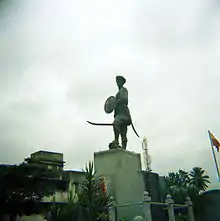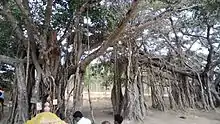Sangolli Rayanna
Sangolli Rayanna (15 August 1796 – 26 January 1831) was an Indian military soldier, revolutionary and warrior in the Kittur princely state of the Karnataka. He was the Shetsanadi of the Kingdom of Kittur ruled at the time by Rani Chennamma and fought the British East India Company till his death. His life was the subject of the 2012 Kannada film Sangolli Rayanna.
Sangolli Rayanna | |
|---|---|
 | |
| Born | Rayanna 15 August 1796 |
| Died | 26 January 1831 (aged 34) Nandagad,TQ: Khanapur (Beedi) Dist:Belagavi (Dharawad) |
| Burial place | Nandagad,TQ: Khanapur (Beedi) Dist:Belagavi (Dharawad) |
| Nationality | Indian |
| Other names | Rayanna Bharamappa Rogannavar |
| Occupation | Kittur Military Shetsanadi |
| Title | Krantiveer |
Activities
Sangolli Rayanna participated in the 1824 rebellion and was arrested by the British, who released him later.He belongs to Bedara nayaka tribe community where British wrote in books that he was a Nayaka Valmiki.[1] He continued to fight the British and wanted to install the adopted son of King Mallasarja and Rani Chennamma, namely Shivalingappa as the ruler of Kittur.[2] He mobilised local people and started a guerilla type war against the British.[2] He and his guerrilla army moved from place to place, burnt government offices, waylaid British troops and plundered treasuries.[2] Most of his land was confiscated and what remained of it was heavily taxed. He taxed the landlords and built up an army from the masses. The British troops could not defeat him in open battle. Hence, by treachery, he was caught in April 1830 and tried by the British; and sentenced to death.[2] Shivalingappa, the boy who was supposed to be the new ruler, was also arrested by the British.[2]
Rayanna was executed by hanging unto death from a Banyan tree about 4 kilometers from Nandagad in Belagavi district on 26 January 1831.[3]
Rayanna was helped by Gajaveera, a Siddi warrior, in his revolt against the British in 1829–30.[4]
Rayanna was buried near Nandagad. Legend says that a close associate Sangolli Bichugatti Channabasappa of Rayanna planted a banyan sapling on his grave. The tree is fully grown and stands to this day. An Ashoka Stambha was installed near the tree. A small temple in the name of Sangolli Rayanna was constructed at Sangolli village, in which stands a statue of Rayanna flanked by two wooden weights used for body building. Two wooden weights are original, those were used by Rayanna himself for body building. A community hall built in commemoration of Rayanna at Sangolli serves the villagers of Sangolli. Karnataka Government recently established Krantiveer Sangolli Rayanna authority its work progress of Krantiveer Sangolli Rayanna Sainik school,"Shouryabhoomi" Krantiveer Sangolli Rayanna rock garden and in "Veerabhoomi" Krantiveer Sangolli Rayanna museum.[5]
In popular culture
Ballads and other memorials

The Gee Gee songs (Ballad) are heroic folklore verses composed in North Karnataka[6] and several such songs are sung about Kittur Chennamma, Sangolli Rayanna and other figures of pre-independence Karnataka.[7] A life size bronze statue of Sangolli Rayanna, riding a horse with open sword in right hand, was installed near Railway station of Bengaluru.[8] The main railway station of Bengaluru City has been renamed as "Krantiveera Sangolli Rayanna Railway station" in 2015.[9] However the station officially re named and notified as "Krantivira Sangolli Rayanna" Railway Station on 03-02-2016[10]
Film
In 2012, a film was produced on his life history.[11] was the subject of another Kannada-language motion picture Kraanthiveera Sangolli Rayanna (Legendary Warrior Sangolli Rayanna), directed by Naganna and starring Darshan Thoogudeep, Jayaprada and Nikita Thukral.[11]

Citations
- "Sangolli Rayanna and the rise of caste heroes". Newindian Express, Bangalore. Retrieved 6 December 2016.
|first1=missing|last1=(help) - Gopalakrishnan(Editor), Subramanian; Gopalakrishnan, edited by S. (2007). The South Indian rebellions: before and after 1800 (1st ed.). Chennai: Palaniappa Brothers. p. 103. ISBN 9788183795005.CS1 maint: extra text: authors list (link)
- R P, Sambasadashiva Reddy. "Miscellany". Deccan Herald, Bangalore. Retrieved 5 November 2012.
- Ali, Shanti Sadiq (1996). The African dispersal in the Deccan : from medieval to modern times. New Delhi: Orient Blackswan. p. 232. ISBN 9788125004851.
- "ಪೂರ್ಣವಾಗದ ಸಂಗೊಳ್ಳಿ ರಾಯಣ್ಣ ಪ್ರಾಧಿಕಾರ". Vijaya Karnataka. 9 August 2018. Retrieved 28 August 2020.
|first1=missing|last1=(help) - Khajane, Muralidhara (8 April 2008). "We've come for your vote…". The Hindu. Retrieved 30 November 2012.
- Datta, Amaresh (Ed.) (1988). Encyclopaedia of Indian Literature: devraj to jyoti, Volume 2. New Dehi: Sahitya Akademi. p. 1293. ISBN 9788126011940.CS1 maint: extra text: authors list (link)
- "Sangolli Rayanna statue unveiled in City, at last". Deccan Herald, Newspaper. 28 September 2010. Retrieved 17 September 2015.
- "Bengaluru railway station to be named after Sangolli Rayanna". Deccan Harald, Newspaper. 1 May 2015. Retrieved 17 September 2015.
- http://www.scr.indianrailways.gov.in/view_detail.jsp?lang=0&id=0,5,268&dcd=7096&did=145449704189594354ECD102CEC97451280C24522002C.web91
- Khajane, Muralidhara (31 October 2012). "Rajyotsava release for Sangolli Rayanna". The Hindu. Retrieved 30 November 2012.